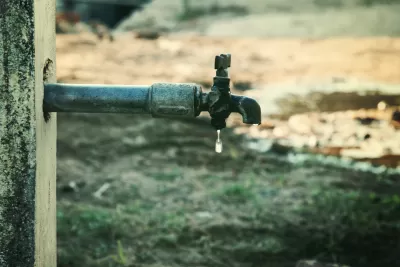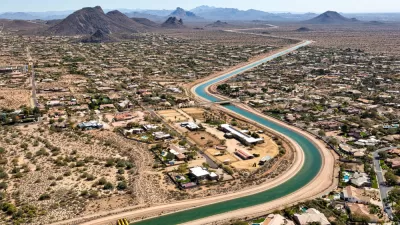New tools and technologies of the so-called Internet of Things are helping cities get a better handle on water scarcity and overabundance.

"Whether cities face scarcity or abundance—forced to conserve water or plan for torrential rain—new tools are emerging that leverage the Internet of Things to effectively manage water," according to an article by Laura Adler.
Adler goes on to survey the different types of technologies in use in cities around the country. For instance: " Companies such as Hortau and CropX and nonprofits like Santa Cruz County’s Community Water Dialogue are implementing radio- or cellular-enabled sensor systems that track variables including rainfall, humidity, soil composition, topography, temperature, and sunlight. Coupled with analytics and weather prediction data, this information enables farmers to make smarter decisions about irrigation."
On the drought side of the equation, Adler also mentions technological innovations for irrigation on municipal properties and for preventing leaks from urban water transportation systems.
For managing stormwater, Adler notes that the Internet of Things is helping cities plan for and anticipate heavy rainfall. For instance: "Firms like Opti are helping cities pull together data from water storage facilities and weather predictions to ensure that there is sufficient space to collect and process rainwater runoff. With analytics and smart infrastructure management, cities can plan for maximum runoff capture and processing, with the dual benefit of increasing water harvesting and reducing pollution."
FULL STORY: Come Drought or High Water

Alabama: Trump Terminates Settlements for Black Communities Harmed By Raw Sewage
Trump deemed the landmark civil rights agreement “illegal DEI and environmental justice policy.”

Planetizen Federal Action Tracker
A weekly monitor of how Trump’s orders and actions are impacting planners and planning in America.

The 120 Year Old Tiny Home Villages That Sheltered San Francisco’s Earthquake Refugees
More than a century ago, San Francisco mobilized to house thousands of residents displaced by the 1906 earthquake. Could their strategy offer a model for the present?

Ken Jennings Launches Transit Web Series
The Jeopardy champ wants you to ride public transit.

BLM To Rescind Public Lands Rule
The change will downgrade conservation, once again putting federal land at risk for mining and other extractive uses.

Indy Neighborhood Group Builds Temporary Multi-Use Path
Community members, aided in part by funding from the city, repurposed a vehicle lane to create a protected bike and pedestrian path for the summer season.
Urban Design for Planners 1: Software Tools
This six-course series explores essential urban design concepts using open source software and equips planners with the tools they need to participate fully in the urban design process.
Planning for Universal Design
Learn the tools for implementing Universal Design in planning regulations.
Clanton & Associates, Inc.
Jessamine County Fiscal Court
Institute for Housing and Urban Development Studies (IHS)
City of Grandview
Harvard GSD Executive Education
Toledo-Lucas County Plan Commissions
Salt Lake City
NYU Wagner Graduate School of Public Service





























